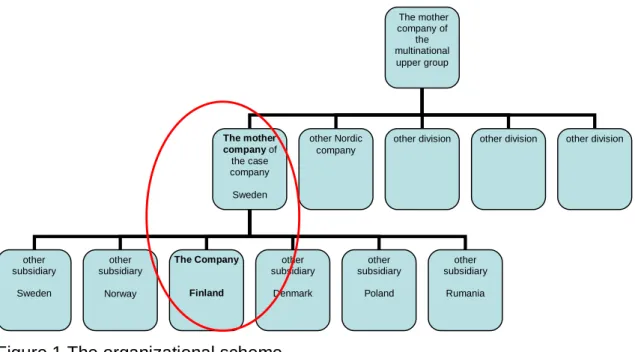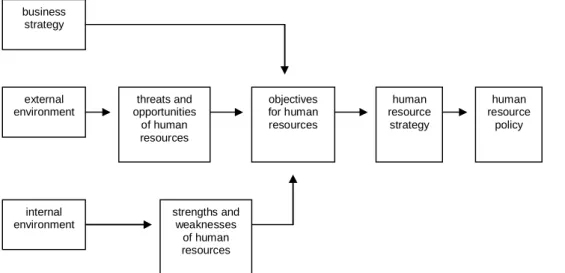The results of the investigation show that most legal requirements were in order in the company. Guidelines given by the group were also taken into account in the company's HR practices.
Background of this study
The case company
Group products include, for example, sandwich panels for walls and load-bearing roof panels and rainwater systems. In addition, there are four sales offices in Finland, two of which also have smaller sales warehouses.
Objectives of the study and research question
The company employs approximately 60 people and on top of that there are about 20 seasonal workers during the summer. The findings of this thesis are also intended to be used for further discussions about the Company's HRM issues and responsibilities.
Research method and structure
Also, some observations on the organization of the HR function and its role will be made based on the literature. In order to understand what is the role and requirements of the Group for the local unit, the reasons and ways of transferring human resource practices from a parent company to a subsidiary will be studied.
Main concepts
In the next six chapters, the most important aspects of human resources will be studied through the literature on human resource management. The same aspects will be examined in the Company and the current status of its HRM will be described later in this report, in chapter 5.
HRM
These will be reviewed in order to create a picture of well-managed HR procedures based on current knowledge. It is the manager's job to share information about goals with everyone and allow employees to be involved in planning how these goals will be achieved.
SHRM
Source for competitive advantage
Strategic HRM makes it possible to make strategic decisions that have a large and long-term impact on the organization's behavior and success by ensuring that the organization attracts, recruits and retains the skilled, committed and well-motivated employees needed to achieve sustainable . competitive advantage. Identifying how HRM will add value to the organization is a high priority. 2006, p. 54) emphasizes that human resource management activities must add value to the organization.
Common view on future and employees' commitment
Eigenhuis & van Dijk (2008, pp. 18–20) believe that the most important question to start any analysis to develop strategic HRM and action plans is: “What business are we in and what are the key success factors? '. Identifying these specific attributes and critical success factors will lead to the right decision regarding what HRM should prioritize and where to focus its efforts and resources.
SHRM conclusions
A shared vision and strategy certainly helps to increase the level of involvement or buy-in, especially if the shared vision is combined with the concept of an organization that does business successfully but also meaningfully.
HR strategy
HR strategies will focus on the intentions of the organization about what needs to be done and what needs to be changed. The second type is specific HR strategies that outline what the organization intends to do in areas such as talent management, continuous improvement, knowledge management, resource provision, learning and development, reward or employee relations.
HR policy
HR policies should be designed for and targeted at front line managers as they will be primarily responsible for policy implementation. Line managers are mainly responsible for policy implementation, but of course receive support from the HR function for communicating and interpreting policy.
HR practice
What kind of HR practices are needed
HR practices determine the ways in which certain actions concerning people are to be carried out by management or individual managers. The introduction or development of HR practices must be carried out in consultation with employees or their representatives.
HR practice conclusions
It is important to inform everyone about how the procedures work, which is why they should be published. Special training and support should be given to superiors on how to implement and apply the practices.
HR organization
- Organization models
- Devolved HRM
- Special features of SMEs
- HR organization conclusions
HR should participate in strategic decision-making and enable decentralization of many activities to the line managers. Recognizing the importance of HRM to company performance is critical as managerial incompetence in dealing with HRM issues is a major source of small business failure. However, there are some risks that need to be considered before devolving more HRM down the line.
Recognizing the importance of the entire HRM to the company's performance is critical because a major source of SME failure is attributed to managerial incompetence.
Dimensions of transferred practices
The aim is to improve business performance without sacrificing the subsidiary's autonomy and to achieve the desired level of global consistency and local sensitivity while keeping the subsidiary's core competence alive. The subsidiary's position as an interpreter of host context constraints for headquarters is often necessary in the field of HR. Internalization, i.e. the second dimension, means the extent to which externally imposed rules are internalized in the recipient unit, when they are taken for granted and accepted by employees, and when employees feel the value of using this new practice.
There is a risk that only ritual imitation of the practices has been carried out if the recipients do not believe in the practice or see its value, most likely resulting in the cessation of the practice.
Factors influencing transfer and governance of practices
In the following chapters, the current status of HRM in the company will be examined based on the strategic framework for HRM. The questions are based on literature and a preliminary study carried out in the first phase of this research. The current status of HRM in the case company was clarified in discussions with the management team (the company's finance manager, sales director, production manager and materials manager) based on the categories defined in the previous phase.
The last chapter (5.3) focuses on personnel organization and responsibilities in the field of personnel in the case of a company.
SHRM, HR strategies and HR policies
The HR function in the Group
The Group's HR function also had to spend resources due to the structural changes at the start of this recession. It must also be clarified where it can benefit from best practices and how it must work to enable the Group's business strategy. Through these actions, SHRM will exist in the Group and probably HR function will create some added value.
According to the former HR director, the group has strategic HRM, but it should be an area of higher priority in the future.
Guidance given from the Group
Since there are no local agreements on flexible working hours in the company, the law must be followed. In the company, these vacations were agreed on a case-by-case basis with the head of the department. In the empirical part of the thesis, the current state of HRM in the company was identified.
After analysis, it turned out that most legal requirements were in order in the company.
HRM practices
HRM instructions in the Company
The company has in its quality and environmental management system some general guidelines for HR issues. This contains the vision, business concepts and values of the Group, as well as the overall responsibilities and authorities for the various managers in the Company. I think the Company should focus and invest more in the future needs regarding the personnel and their skills.
In this way, the importance and value of HR instructions will be better understood at all levels in the Company.
State of statutory demands
- Recruiting and employment relationship
- Working hours and absences
- Termination of an employment relationship and lay-offs
- Health and safety at work
- Cooperation at work
The time of transferred holiday is agreed upon in consultation with the employer and employee. The employer must inform the employee of the reasons for the refusal. The duration of the notice period is laid down in Chapter 6 of the Employment Contracts Act.
The employer is responsible for safety at work in accordance with the provisions of the Working Conditions Act. There is an occupational safety and health policy in the company, but it is quite limited. This occupational health and safety action plan could be part of the occupational health and safety policy.
HR Organization
By clarifying roles and responsibilities, the company can ensure that all requirements of that law are met. Do they have enough time to develop or plan the company's human resources or even proper management duties with their subordinates? In this way the Company can ensure that all legal requirements can be met.
The company does not have a specific commission for cooperation regarding the requirements of the Law on cooperation within enterprises.

The most urgent improvements
- The cooperation procedure
- Documents
- The occupational health and safety
- Handling of job applications
First, the company must decide who is responsible for maintaining this document and whether it should be combined with personnel and training plans. The company must also define how management can monitor the implementation of this document and evaluate it. The company must initially determine rules for the job application register and who is responsible for it.
Arguably, all recruitment activities and their management should be centralized to one person in the company.

Smaller and less urgent improvements
Rules and instructions are also needed so that the company can avoid difficult situations with, for example, a 3-month winter vacation. Table 2 summarizes the less urgent improvements listed in Chapter 6.2 and recommendations for improving the current situation. Laws that an employer must display in the workplace are not necessarily easy to find.
Certain working time practices must be determined to meet the needs of the employer as well as the law.
Some other ideas for improving HR practices in the Company
Perhaps the company should define some training frameworks in the HR handbook or in the plan regarding personnel and training objectives. It was already mentioned in chapter 5.3 that no one has the primary responsibility for training in the company. Before writing the HR handbook, the remuneration system in the company should be thoroughly thought through.
Regarding these improvements, an action plan with schedules and responsibilities should soon be made in the company.



